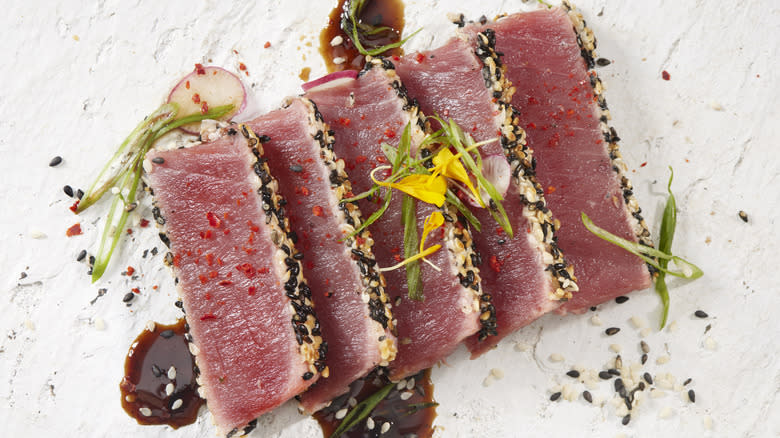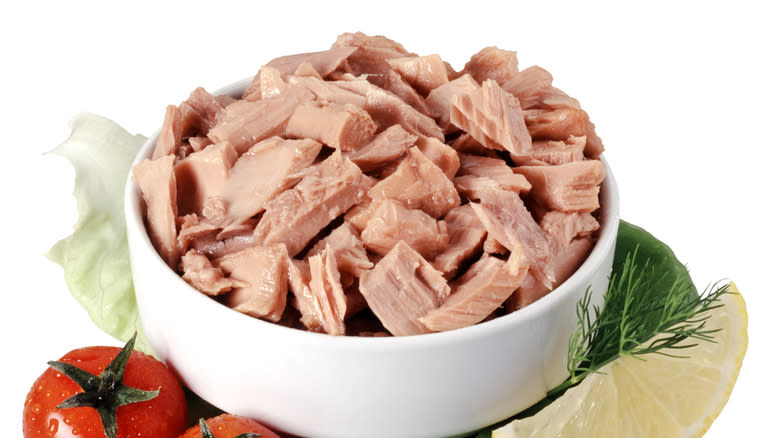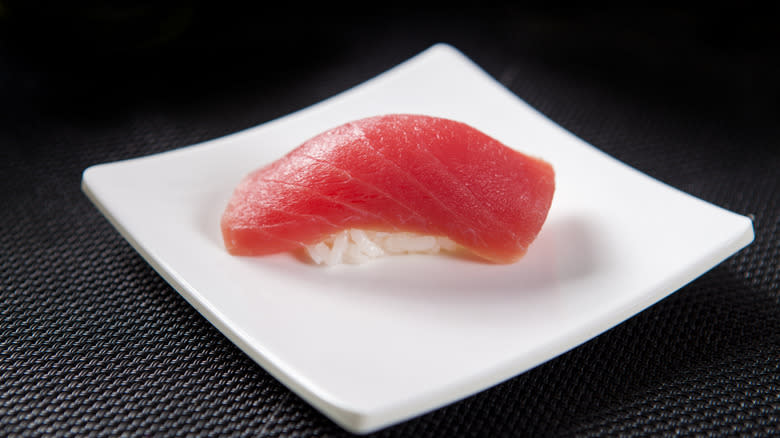What Is The Safest Type Of Tuna To Eat?

Tuna is one of the most popular commercial fish varieties in the world, and is also one of the most versatile. You can select between various kinds of tuna, from canned skipjack and albacore for tuna salad to mid-tier ahi for tuna steaks to ultra-expensive bluefin (the premier sushi fish in the world). Whichever variety you pick (or want to pay for), there's something there for you to enjoy.
There's just one problem: Some varieties of tuna are much better for you than others, due to a potentially toxic substance in nearly all fish, namely mercury. According to the CDC, a lethal dose of mercury for the average person is around 200 mg, meaning you'd have to eat a pretty high amount of fish to get there. Of course, nobody wants mercury poisoning, so which types of tuna have the lowest mercury content? Surprisingly, more high-end varieties of tuna may actually be the ones to watch out for: The most expensive kind of tuna, bluefin, is quite possibly the worst for mercury content, according to Mercury Facts and Figures. And it doesn't work consistently the other way around, either -- the cheapest tuna isn't necessarily the best for avoiding mercury.
Read more: 12 Underrated Types Of Fish You Should Try At Least Once
Mercury Poisoning Is No Joke

First things first: mercury poisoning is awful. Per the National Institute of Health, mercury poisoning has a long list of symptoms, including but not limited to: muscle pain, fatigue, insomnia, depression, tachycardia, and excessive salivation. It can even cause nephritic syndrome, which was the 10th leading cause of death in the United States in 2021, according to the CDC. The threat of mercury poisoning is very real: actor Jeremy Piven once had to leave his work on Broadway when medical tests revealed potentially toxic levels of mercury in his blood, which he attributed to eating fish two times a day for 20 years, according to the New York Times.
Nearly all seafood contains some mercury levels, but the levels vary -- shrimp, for instance, is low on the scale, while swordfish is exceptionally high. Fish accumulate mercury from eating other seafood, and levels can be heavily exacerbated by increasing mercury pollution, which can be emitted into the air and oceans through burning fossil fuels. Generally, this means that older fish have higher mercury levels because they've had more time to be exposed to it. So, are the shortest-lived tuna fish the least mercury-laden? Not quite. While the worst tuna for mercury is also the longest-lived (bluefin, which live an average of 15 years), the best (skipjack) falls somewhere in the middle of tuna age ranges.
Watch Out For Bluefin And Bigeye Tuna

Bluefin and skipjack sit at opposite ends of the spectrum for mercury content, and luckily, it's pretty easy to identify which is which. You will never, ever see bluefin in a can -- it's far too expensive for that. It also clocks in at a staggering 1.0 part per million (ppm) for mercury, marking it as one of the most mercury-laden fish in the ocean, in the same tier as swordfish. Skipjack, by contrast, is often labeled "light tuna" for exactly this reason: at around 0.144 ppm for mercury, it's at the far low end of the spectrum.
Those aren't the only two types of tuna, though. Yellowfin and albacore are both sold canned and fresh, and both sit right around the same range at roughly 0.35 ppm of mercury. But there's also bigeye. Surprisingly, while bigeye and yellowfin tuna are both often known as "ahi," one contains much more mercury than the other, with bigeye containing roughly double the amount. So, if you want a bite of tuna, but want to avoid high mercury levels, pick anything other than bluefin or bigeye.
Read the original article on Daily Meal.

